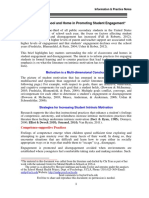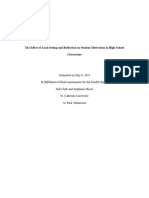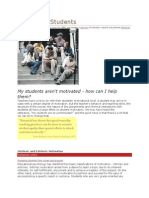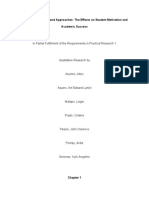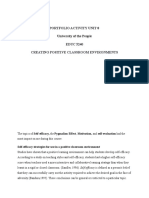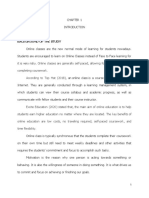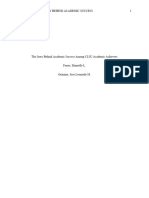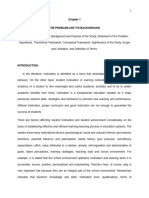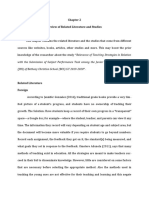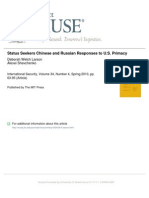Dennis Et Al 2007 The Little Engine That Could - How To Start The Motor - Motivating The Online Student
Dennis Et Al 2007 The Little Engine That Could - How To Start The Motor - Motivating The Online Student
Uploaded by
hoorieCopyright:
Available Formats
Dennis Et Al 2007 The Little Engine That Could - How To Start The Motor - Motivating The Online Student
Dennis Et Al 2007 The Little Engine That Could - How To Start The Motor - Motivating The Online Student
Uploaded by
hoorieOriginal Description:
Original Title
Copyright
Available Formats
Share this document
Did you find this document useful?
Is this content inappropriate?
Copyright:
Available Formats
Dennis Et Al 2007 The Little Engine That Could - How To Start The Motor - Motivating The Online Student
Dennis Et Al 2007 The Little Engine That Could - How To Start The Motor - Motivating The Online Student
Uploaded by
hoorieCopyright:
Available Formats
The Little Engine That Could How to Start the Motor?
Motivating the Online Student
Kay Dennis, EdD Assistant Professor of Adult Education Park University Lisa Bunkowski, PhD Assistant Professor of History Park University Micheal Eskey, PhD Assistant Professor of Criminal Justice Park University Motivation is a function of initiating and sustaining goal-directed action. In addition to individual variables, student motivation is influenced by situational variables that include course design, instructional approach, and to a great extent, faculty behavior. This article presents classic literature on motivation and offers a grounded set of instructional methods and strategies with which faculty can spark and sustain motivation that leads to deep rather than superficial learning in the online learner. These classic motivational techniques have a direct relationship with today's online learner. The authors highlight the significance of external influences and describe some of the many opportunities available to faculty to enhance the motivation of online students to learn. Introduction With the growth of distance learning and changes in family working roles, the typical student profile has shifted from the "traditional" 18-22 year-old full-time undergraduate student residing on campus toward the employed, older college student who struggles to balance education with job and family (Allen and Seaman, 2006). Allen and Seaman suggest that online students tend to be older, work fulltime or hold additional employment, and have more outside and family responsibilities when compared to the more traditional student. Valued rewards vary according to personal goals. This paper examines how faculty in colleges and universities can motivate and meet the needs of online adult learners and thereby play a critical role in improved rates of completion of continuing higher education. Any analysis of student achievement, in Why is motivation so order to guide strategies for improvement, must important for learning include an examination of what drives behavior success? It is the "key to motivation. Why is motivation so important for persistence and to learning learning success? It is the "key to persistence that lasts. The challenge is and to learning that lasts. The challenge is to to help each person clarify help each person clarify his or her important his or her important purposes and then to find, or create, the purposes and then to find, combination of educational experiences that lead or create, the combination to those desired outcomes" (Chickering and Kuh, of educational experiences 2005, p. 1). that lead to those desired Student motivation both typically and outcomes." naturally has to do with the students desire to participate in the learning process. Motivation reflects the reasons or goals that underlie their involvement or noninvolvement in academic activities (Lumsden, 1994). Greater initiative, tenacity, and self-discipline are needed to take courses in the online environment than in the traditional classroom (Mandernach, et al., 2006). A student who is intrinsically motivated undertakes an activity "for its own sake, for the enjoyment it provides, the learning InSight: A Collection of Faculty Scholarship 37
it permits, or the feelings of accomplishment it evokes" (Lepper, 1988, p. 290). Conversely, an extrinsically motivated student performs and strives to succeed "in order to obtain some reward or avoid some punishment external to the activity itself," such as grades or teacher approval (Lepper, 1988, p. 290). For example, some students are motivated more by the goal of the degree than the education; some may be motivated by the promotion that follows the degree; still others by the prestige in the eyes of their family and friends. Although students may be equally motivated to perform a task, the sources of their motivation may differ. As instructors we must find these differences and, subsequently, the differing motivators. We must determine if they are intrinsically or extrinsically motivated, or a combination thereof. In this article the authors explore motivation to learn, and propose specific approaches for online faculty interested in strengthening their students' motivation to learn. Goal Orientation Motivation derives from a variety of forces. It is dynamic, highly subject to change, and a major factor in readiness and desire to learn (Cashin, 1979). Students choose to exert a specific type and level of effort, and their reasons are as diverse as their attitudes and abilities. As these authors have discovered, students may be equally motivated to perform a task, yet Motivation derives from a the sources of their motivation may differ. Online variety of forces. It is instructors must recognize, monitor, and attempt dynamic, highly subject to to influence those factors that motivate students. change, and a major factor A number of factors are important to in readiness and desire to online students. They want independence; learn. however, they also want and value timely faculty interaction (Northrup, 2002). It is important, beneficial, and useful for online instructors to make their classroom settings as "real" and live for the student, through strategies such as "hands-on" empirical research assignments, using student mentors, including oral communications (telephone, video, MP3, two-way synchronous chats, etc.), and working with local practitioners to coordinate student internships (Mandernach, et al., 2006). Among the motivation-related concepts examined was achievement goal orientation (Dweck, 1986). Dweck proposed that students who possess intrinsic (or mastery) orientation long for new skills and knowledge. They find satisfaction in the innate rewards of learning. This attitude guides their achievement behavior, which emphasizes contextualized learning. Intrinsically or mastery oriented students engage with the content, their peers, and faculty, netting a longer retention span and a greater ability to use what they learn. Such students are independent, lifelong learners (Chasteuneuf, 2006). In contrast, students with extrinsic (or performance) orientation concern themselves with achievement chiefly in relation to their peers (Vansteenkiste and Lens, 2006). They use rote memorization and study for immediate gain according to what they expect to see on a test. These behaviors may be observed in students enrolled in introductory-level courses or general education requirements. Such learning carries a brief life expectancy and is superficial (Ames, 1990). In the experience of these authors, extrinsically motivated students are seeking benefits such as grades, positive feedback or other indicators of teacher approval. Many such students openly disclose the incentives that motivate their efforts, such as maintaining a grade average to preserve financial aid, fulfilling degree requirements, improving career prospects, or winning the approval of significant others. Metacognition Motivated students direct their learning very deliberately. After goal orientation, another factor associated with motivation and learning success involves 38 Volume 2, Student Motivation, 2007
self-regulating and monitoring strategies, known collectively as metacognition (Flavell, 1979). Students possessing metacognitive skills and habits are aware of their cognitive processing methods and employ study behaviors appropriate to the situation. Hallmarks of metacognition include a heightened awareness of one's thinking, selection of processing strategies from a repertoire, reflection and readjustment, and sustained motivation to achieve (Paris and Winograd, 2004). Self-Efficacy Another individual variable relates to perception of one's ability to learn subject matter successfully. Self-efficacy, as described by Bandura (1986), refers to one's sense of ability to succeed at a given task to a specified level. Self-efficacy is a task-specific quality; a student may be a talented and confident pianist (and therefore enjoy a sense of self-efficacy at piano-playing), yet be painfully aware of low achievement in a history class (and will feel inefficacious there as a result). Students who perceive themselves as limited in capability lack the confidence, energy and motivation that successful study efforts bring. Their achievement behavior is limited. They regulate themselves away from attempting a rigorous academic effort because, based on experience, they do not "see" it happening (Ames, 1990). Situational Variables While some would suggest that a student's goal orientation, and by extension the students motivation, affects response to individual or situational variables, Chasteauneuf (2006) countered that the real issue is how those internal and external variables inform a student's choice of goal orientation. This is a powerful thought, since external factors such as social forces clearly affect motivation (Bandura, 1971). Situational variables take many forms. Motivation in most students is socially mediated, affected by influences including classroom dynamics. Consider the effects of sarcastic or deprecating comments following a student's erroneous statement which sometimes occurs in the classroom. When it happens in the online environment, the authors believe its effects can be especially damaging because peer replies are visible onscreen for weeks to come. The hapless student who spoke in error cannot soothe his embarrassment with hopes the gaffe will be forgotten; it is in full view of everyone. He or she is unlikely to volunteer another statement soon. According to Ames (1992), motivational considerations include various cues found in the course, such as learning expectations stated in the syllabus or by the instructor. Students utilize these cues to form impressions of the value or importance of a learning task, assignment, or the course as a whole. For example, students may respond to an assignment by deciding that it is of little consequence, so they decide not to exert their best effort. In such a case superficial learning may not be followed by deeper consideration of Of all the situational the topic. Students gauge the difficulty of variables affecting student the course and assess its value for their motivation, perhaps none needs and purposes. In a course that exerts such a strong and fosters commitment and motivation to pervasive effect as faculty learn, students can thrive. attitudes and behavior. Faculty Behavior Of all the situational variables affecting student motivation, perhaps none exerts such a strong and pervasive effect as faculty attitudes and behavior. Instructional communication such as giving feedback on performance constitutes a prime opportunity either to enhance motivation or decimate it. Receiving feedback or a grade on performance creates a high-stakes situation for students, for they take it very personally, and not only in the academic sense. Their self-esteem and InSight: A Collection of Faculty Scholarship 39
self-efficacy are affected; they either find themselves on solid footing or in quicksand. Therefore, the manner in which feedback is delivered, particularly in the online environment, is of paramount importance. Lacking the opportunity to provide the face-to-face immediacy found in the physical classroom, online instructors are challenged to find other means of closing the social and psychological distance between themselves and their students (Arbaugh, 2001). Verbal interaction between Lacking the opportunity to instructors and students is vital. Instructors in provide the face-to-face online courses, more so than in face-to-face immediacy found in the courses, must seek evidence of students' physical classroom, online feelings and motivation, especially their instructors are challenged reactions to the written word, which is devoid to find other means of of vocal tone. This interaction can be fostered closing the social and by using students' names in discussion posts, psychological distance sharing personal anecdotes related to course between themselves and concepts, and encouraging students to their students. respond to instructor questions as well as to comments made by their peers (Hutchins, 2003). Working with peers reduces learner anxiety and is an effective method of increasing the motivation of online students (Moore, 2006). The more effort online instructors put into closing that social and psychological gap in their class discussions using appropriate immediacy behaviors, the greater the reward in student interaction (Arbaugh, 2001). In order to improve performance and at the same time sustain desire to learn, feedback is best delivered respectfully, tactfully and constructively, so as to save face. Face refers to the positive self-image students hope to internalize and preserve through interactions with others. If face is threatened, a student may withdraw from interaction and engagement with assigned tasks. Consequently, the level of motivation declines. On the other hand, faculty guidance, recognition and approbation yield an increase in student motivation to exert greater effort (KerssenGriep, 2003). Additional strategies to enhance motivation include guiding students toward their own discoveries of facts and relationships. Self-esteem grows when students realize success in acquiring, storing, and retrieving key information (Alutu, 2006). They accomplish this through thoughtful questioning and being encouraged to construct knowledge that is personally meaningful and durable over time. Further evidence of the impact of instructor interventions on goal and learning orientation, motivation, achievement and retention of online adult learners was established by Chyung (2000), who determined that the motivational attraction of online instruction for adult learners related to perceptions of the learning climate, learning outcomes, and improved retention of students. Data Collection Effective teaching, support and motivation involve faculty research. What works, and what does not? An optimal way to determine what instructors do to support and motivate their students is to observe them and ask them. The authors formally collected data on over 200 online adjunct instructors during AY20062007. Their observation illuminated a number of key areas: what works; what does not work; what students like; what students do not like; student complaints vs. student praise; stimulating discussions vs. dead spots (Bunkowski, et al., 2006). This examination of more than 200 online adjunct faculty and courses enabled the authors to identify five key dimensions of effectiveness: Interaction, individual attention, timeliness of information and response, information transmission, and accessibility and skill at moderating the flow of learning. These were viewed and assessed through bi-weekly assessments of online student-student and faculty-student interaction in the classroom. 40 Volume 2, Student Motivation, 2007
Success Formula Based on their research, the authors have compiled a "short list" of key elements for consideration by faculty wishing to improve their effectiveness in motivating online students (Bunkowski, et al., 2006): Whenever possible, course topics should be current (for every discipline). A textbook will never be as current as today's primary news medium, the Internet. Excellent resources include CNN (http://www.cnn.com/), Fox (http://www.foxnews.com/), CBS (http://www.cbsnews.com/), and BBC (http://news.bbc.co.uk/). Information from these sources can be integrated in a course and revised as necessary. Whenever possible, course Students are increasingly savvy and enjoy topics should be current (for discussing current events in the city, every discipline). A textbook state, county, region, nation, or world will never be as current as with their classmates. today's primary news A wealth of information is medium, the Internet. available to students. In gathering appropriate material for online discussions, faculty can dispense some of the responsibility to the students. A semi-structured approach allows students some latitude while ensuring they address the course objectives. These authors have discovered that students generally rise to the challenge of exchanging information, directing questions, and seeking clarification at a surprisingly sophisticated level. The online discussion forum is not a place for domination. The key is keeping students on their toes through moderation. Occasional refereeing may be necessary as a last resort. Motivation to learn occurs at strategic intervals, beginning prior to start of term. Faculty have opportunities to spark student interest as course syllabi are posted to the course platform. Figure 1 divides a course into specific points at which suggested motivational strategies can be used with success. More detailed information on ways to engage learners can be found in Appendix A, where The Nine Events of Instruction (Gagne, 1985) are provided along with comments from these authors. Appendix B explains the use of "R2A2"; and Appendix C offers an actual case study illustration of faculty-facilitated metacognition. Connection between Faculty and Student Motivation A critical component of student motivation and the success of the online learning experience is the motivation of the instructor. Student performance, according to Crumpacker, is "contingent on instructor skill and level of effort of motivation" (2001, p.1). The factors that influence faculty motivation include positive factors or incentives, and negative factors or obstacles. Recent studies of online faculty reveal the following motivating incentives for online instruction (McKenzie et al., 2000): Flexible working conditions Enjoyment of on-line instruction Enhanced technological skills Interaction with a diverse student population Increased job satisfaction Ease of updating and revising courses Ability to ensure that course topics are relevant Financial considerations such monetary awards do not appear to be a significant motivating factor (Rockwell et al., 2000). Release time and reductions in faculty workloads are reported to be more desirable than financial rewards at least to senior faculty (Rockwell et al., 1999).
InSight: A Collection of Faculty Scholarship
41
Figure 1: Strategic Steps for Successful Students
Preterm wk. Post syllabus and specific "success" tips Post photograph and a friendly introduction Ask students to post photos and introductions Incorporate some choice on class topics and assignments Verify effective use of section headings, color, text, intuitive flow of course Create a thread to post weekly Teacher's Tips & Tricks and invite student sharing of their best tips Create a virtual loungestudents only Ask students to assess their learning skills and areas for improvement State desire to support learning improvement & your goal that all students will select effective strategies Day 1 of Term Vividly describe course's value in real-life context Log in 2-3 times; be responsive and genuinely enthusiastic Guide students' reading (look for thiscompare) Summarize selfassessments & improvement goals; urge peer support to aid all students Post "primer" on metacognition & model it in a discussion post Ensure an early success for each student; praise and document it Recognize every student in some manner Decide to reduce "mental miles" between faculty and students Internalize caring & show sincere interest in course and all students Consider cultural, diversity factors that could affect motivation End of Week 1 Urge formation of peer learning support pairs Introduce peer critiques of thinking/writing Demonstrate & promote deep versus superficial thinking Stress belief in students' ability to succeed and grow via course Create context Introduce R2A2 Recognize Relate Assimilate Apply (Hill, 1960) See Appendix B Summarize and connect the core course elements Clarify course expectations, performance, and grading Ask students for their best effort: to benefit them Question to self: What effect am *I* having upon my students' motivation to learn? Weekly Aid discovery via good questioning Encourage links among course, life experiences, current events Illustrate type of performance expected Model & discuss expert thinking & processing Praise, reinforce quality efforts Give feedback to each student 1:1 Correct privately and respectfully In group setting, affirm everyone sincerely Re-assess the nature and ways of your thinking Reflect upon the impact you have on your students At Midterm Post & praise student reports of learning improvements "What is/isn't working well in our course?" Asked of the class Summarize course journey to date Schedule time for reflection on subject and on learning successes & challenges Plan efforts & focus for rest of term Devise a plan to motivate self for balance of course Continue using psychological lens to view each student's attitude, effort & performance & adjust yours accordingly WHAT ELSE CAN YOU THINK OF? Final Week Summarize & reinforce CLOs* within context of the major, global society, etc. Emphasize the value of overt learning for academic & career success Encourage all students to extend insights by constantly re-framing the subject matter Urge students to explore the more complex issues & their implications on broader scale Reflect, record lessons learned while teaching this course, for future use HOW CAN YOU USE THESE EXPERIENCES TO IMPROVE YOUR OWN TEACHING & LEARNING? *CLOs = Core Learning Outcomes
JOT DOWN YOUR IDEAS HERE:
According to McKenzie et al. (2000), the major obstacles interfering with instructor motivation include: Decreased live, face-to-face interaction with students Lack of time to plan and deliver an on-line course Lack of support & assistance Burden of training time to learn & update technology skills Inadequate compensation & incentives Heavier workload Slow computer access 42 Volume 2, Student Motivation, 2007
Deubel (2003, p. 1) argues that "an instructor's attitude, motivation, and true commitment toward instruction delivery via distance education programs" have a direct bearing on the quality of online instruction. To optimize faculty motivation and thereby enhance student learning and foster student motivation, one must maximize the incentives and minimize the obstacles. As instructors move from the traditional classroom to the online learning environment, their roles change from "teacher" to "facilitator, mentor and coach" (Yang and Cornelious, 2005, p. 216), or "learning catalyst" (Volery and Lord, 2000, p. 4). The following suggestions can help to support online faculty as they make this transition, and to sustain their satisfaction and high level of motivation (Crumpacker, 2001; Deubel, 2003; Rockwell et al., 2000; McKenzie et al., 2000; Rockwell et al., 1999; Yang and Cornelious, 2005): Training with emphasis on: o Online pedagogy o Adult learning theory o Technology skills o Course facilitation o Institutional Policies & procedures Communication with administration Peer mentoring Evaluation of instructors & courses Ongoing training in course delivery/management system Professional development opportunities Ongoing technical support Manageable class sizes Reward system (Priority course assignment, stipend awards, release time, etc.) Motivated instructors are better able to guide and motivate students as they assume a more active role as online learners. Students are more likely to have a positive learning experience with instructors who hold a positive attitude about teaching online (Yang and Cornelious, 2005; Volery and Lord, 2000). Conclusion As we shift from an institution of face-to-face student-instructor interaction to online instruction it is increasingly important that we dedicate the needed time and resources to programs that address the As we shift from an unique challenges of online students. It is institution of face-to-face important that we embrace the factors that student-instructor motivate our students, predict the success of interaction to online our students and reflect the practices of instruction it is increasingly successful online instructors in online important that we dedicate teaching. the needed time and From this research, we may both resources to programs that gather and add to the best practices employed address the unique by instructors in the motivation of online challenges of online students. As indicated by the observations of students. the authors within the context of this study and through faculty evaluations and observations, a clear distinction exists between the needs of in-class versus online students. Further, the motivators of online students include, but certainly are not limited to, timely course material, information sharing between faculty and students, and mediation and moderation by involved instructors. Each of these factors involves dedicated and motivated instructor interaction which, in turn, affects student motivation. The current research points to a need for ongoing and further research in the area of motivating our growing population of online students. InSight: A Collection of Faculty Scholarship 43
References Alutu, A. N. G. (2006). The guidance role of the instructor in the teaching and learning process. Journal of Instructional Psychology, 65, 44-49. Ames, C. A. (1990). Motivation: What teachers need to know. Teachers College Record, 91(3), 409-421. Ames, C. A. (1992). Classrooms: Goals, structures, and student motivation. Journal of Educational Psychology, 84, 261-271. Arbaugh, J. B. (2001). How instructor immediacy behaviors affect student satisfaction and learning in webbased courses. Business Communication Quarterly. 65, 42-54. http://web.ebscohost.com.pegleg.par k.edu/ehost/detail?vid=4&hid=103&s id=26e6da6f-573c-406c-bd9a1b46c48ff953%40sessionmgr104 bib4up#bib4up Bandura, A. (1986). Social foundations of thought and action: A social cognitive theory. Englewood Cliffs, NJ: Prentice-Hall. Bunkowski, L. M., Eskey, M. T. & Gonzales, R. (2006). Ensuring academic quality: innovations in faculty mentorship and evaluation. Sloan-C Conference. Orlando, FL. Cashin, W. E. (1979). Motivating students. Idea Paper No. 1. Kansas State University: Division of Continuing Education Center for Faculty Evaluation & Development. Chasteneuneuf, C. (2006). Motivation and text-based learning. American Educational Research Association Annual Meeting. San Francisco, CA. Chickering, A. W., & Kuh, G. D. (2005). Promoting student success: Creating conditions so every student can learn (Occasional Paper No. 3). Bloomington, Indiana: Indiana University Center for Postsecondary Research. Chyung, Y. (2001). Systemic and systematic approaches to reducing attrition rates in online higher education. American Journal of Distance Education, 15, 36-49. Crumpacker, N., (2001). Faculty pedagogical approach, skill, and motivation in today's distance education milieu. Online Journal of Distance Learning Administration 4:4. Retrieved April 1, 2007, from http://www.westga.edu/%7Edistance /ojdla/winter44/crumpacker44.html Deubel, P. (2003). Learning from reflections Issues in building quality online courses. Online Journal of Distance Learning Administration, 6. Retrieved April 1, 2007, from http://www.westga.edu/~distance/oj dla/fall63/deubel63.htm Diaz, D. P. (2002). Online drop rates revisited. The Technology Source, May - June. Retrieved June 3, 2003, from http://technologysource.org/article/o nline_drop_rates_revisited/ Dweck, C. S. (1986). Motivational processes affecting learning. American Psychologist, 41, 10401048. Flavell, J. H. (1979). Metacognition and cognitive monitoring: a new area of cognitive developmental inquiry. American Psychologist, 34, 906-911. http://web.ebscohost.com.pegleg.par k.edu/ehost/detail?vid=4&hid=103&s id=26e6da6f-573c-406c-bd9a1b46c48ff953%40sessionmgr104 bib9up#bib9up Gagne, R. M. (1985). The conditions of learning and theory of Instruction. Orlando, FL: Harcourt Brace College Publishers. http://web.ebscohost.com.pegleg.par k.edu/ehost/detail?vid=4&hid=103&s id=26e6da6f-573c-406c-bd9a1b46c48ff953%40sessionmgr104 bib10up#bib10up
44
Volume 2, Student Motivation, 2007
Gagne, R, Brigg, L., & Wager, W. (1992). Principles of Instructional Design (4th ed). Boston, MA: Wadsworth Publishing. Hill, N. (1937). Think and Grow Rich. New York: The Random House Publishing Company. Hutchins, H. M. (2003). Instructional immediacy and the seven principles: Strategies for facilitating online courses. Online Journal of Distance Learning Administration, 6. Retrieved March 27, 2007, from http://www.westga.edu/~distance/oj dla/fall63/hutchins63.html Kerssen-Griep, J., Hess, J. A., & Trees, A. R. (2003). Sustaining the desire to learn: Dimensions of perceived instructional facework related to student involvement and motivation to learn. Western Journal of Communication, 67, 357-361. Lepper, M. R. (1988). Motivational Considerations in the Study of Instruction. Cognition and Instruction, 5, 289-309. Lumsden, L.S. (1994). Student motivation to learn (ERIC Digest No. 92). Eugene, OR: ERIC Clearinghouse on Educational Management. Mandernach, B. J., Donnelli, E., & Dailey-Hebert, A. (2006). Learner attribute research juxtaposed with online instructor experience: Predictors of success in the accelerated, online classroom. Journal of Educators Online, 3(2). McKenzie, B. K., Mims, N., Bennett, E. & Waugh, M. (2000). Needs concerns and practices of online instructors. Online Journal of Distance Learning Administration, 1. Retrieved April 1, 2007, from http://www.westga.edu/~distance/oj dla/fall33/mckenzie33.html Moore, J. C. (2006). Collaboration online: Sloan-C Resources. Journal of Asynchronous Learning Networks, 10, 81-89.
Northrup, P.T. (2002). Online learners' preferences for interaction. The Quarterly Review of Distance Education, 3, 219-226. Paris, S. G. & Winograd, P. (2004). The role of self-regulated learning in contextual teaching: principles and practices for teacher preparation. U.S. Dept. of Education. Retrieved April 2, 2007, from http://www.ciera.org/library/archive/ 2001-04/0104parwin.htm Rich, A. (1977). Claiming an education. In A. Kesselman, L. D. McNair, & N. Schniedewind (Eds.), Women: Images & Realities, a Multicultural Anthology. Boston: McGraw Hill. Rockwell, K., Schauer, J., Fritz, S. M., & Marx, D. B. (2000). Faculty education, assistance and support needed to deliver education via distance. Online Journal of Distance Learning Administration, 3. Retrieved March 28, 2007, from http://www.westga.edu/~distance/ro ckwell32.html Rockwell, S. K., Schauer, J., Fritz, S. M., & Marx, D. B. (1999). Incentives and obstacles influencing higher education faculty and administrators to teach via distance. Online Journal of Distance Learning Administration, 2. Retrieved March 28, 2007, from http://www.westga.edu/~distance/ro ckwell24.html Svinicki, M. (2005). Student goal orientation, motivation, and learning. IDEA Paper 41. Kansas State University: Division of Continuing Education Center for Faculty Evaluation & Development. Volery, T. & Lord, D. (2000). Critical success factors in online education. The International Journal of Educational Management, 14, 216 223.
InSight: A Collection of Faculty Scholarship
45
Yang, Y. & Cornelious, L. F. (2005). Preparing instructors for quality online instruction. Online Journal of Distance Learning Administration, 8. Retrieved 1 April, 2007, from http://www.westga.edu/~distance/oj dla/spring81/yang81.htm
Dennis is Chair of the Adult Education Graduate Program and an Online Instructor Evaluator in the College for Distance Learning at Park University. She received her EdD in Higher Education Administration from North Carolina State University, her MSN in Nursing Management from East Carolina University, and her BSN in Nursing from the University of Kentucky. She has taught at Eastern Kentucky University, East Carolina University, Boston University, and now at Park University. Her scholarly interests relate to the cross-cultural and faculty behavioral aspects of academic success of students. Bunkowski is an assistant professor of history at Park University and is currently on half-time academic release as an online instructor evaluator and mentor for the College for Distance Learning. Bunkowski earned her PhD in history from the University of Kansas, an MA in history and a BA in Spanish, cum laude, from Emporia State University. She has taught for Park University since 2004. Her current areas of historical research include violence and vigilantism in the mid-19th Century American West, with an emphasis on class, race and ethnicity in the geographic region of Kansas, Oklahoma and Texas. She is actively engaged in developing strategies for building community in the online classroom, and improving online teaching and learning. Additionally, she is a course developer, and is involved in developing new programs for Park Universitys College for Distance Learning. Eskey is currently an assistant professor of criminal justice at Park University. Additionally, he is a course developer and online instructor evaluator for the Park University College of Distance Learning. He earned his Ph.D. in Criminology from the Florida State University (1982), an M.A. in Criminal Justice from the University of Nebraska at Omaha (1977), an M.S. in Strategic Intelligence from the Joint Military Intelligence College (1994), and a B.S. in Criminal Justice from the University of Nebraska (1975). He has taught criminal justice courses at both the undergraduate and graduate levels. His current research includes the area of homeland security and the delivery of online instruction to the unique student audiences of both the criminal justice field and the military. 46 Volume 2, Student Motivation, 2007
Appendix A: Gagne's Nine Events of Instruction Instructional Event Gain and control students' attention. Specific Action for Faculty Enthusiastically describe your own interest in the course/topic and its value to you. Motivation sparks motivation. Describe the journey about to begin. Remind students of their previous mastery of necessary verbal and intellectual skills. Introduce course material in an orderly and well-organized fashion. Carefully constructed questions induce discovery. Students practice using concepts; solve problems, etc. Prompt, frequent, specific feedback during early stages is critical to achievement, self-efficacy, and motivation. Encourage and guide students to provide their own feedback assess their own learning for completeness and accuracy (metacognition). Provide multiple opportunities for students to demonstrate and verify achievement. This promotes retention, self-efficacy, and enhances motivation. Periodically ask students how they are connecting what they are learning to their own lives. Generalizability promotes learning, motivation, etc. Assign practical learning tasks that require recall and significant effort, etc.
Inform students of expected outcomes. Stimulate recall of relevant prerequisite capabilities.
Present the stimuli for learning, according to the kind of learning required. Offer guidance for learning.
Provide feedback.
Appraise performance.
Make provisions for transfer of knowledge.
Insure retention.
Appendix B: R2A2 Recognize Relate Assimilate Apply "R2A2" Napoleon Hill, author of the highly acclaimed 1937 book, Think and Grow Rich, is credited with this phrase. Hill, an American, was referring to a systematic method by which a person could grow in wisdom and thereby become more successful in achieving his or her goals. Hill's powerful and practical words resonated with millions of Americans who were struggling against the Great Depression. To apply R2A2 to teaching and learning in the online environment, an instructor might assign a learning activity such as a well-focused discussion forum. Students would be expected to identify connections among course material, posts by their peers and instructor, and their own contributions to the discussion. The first step is to recognize a concept as familiar, then to relate or connect that concept to InSight: A Collection of Faculty Scholarship 47
another concept perhaps a newly introduced idea, or even a foundational concept from previous course material. Once the student has recognized and related the concepts, he or she is to assimilate or weave them into the context of the discussion, unit, and course. In so doing the student actually uses the material which embeds it further into memory. As the new information becomes personalized knowledge it can be applied to present and future situations. In the online learning environment, such situations might include further discussion postings, online debates, case studies, or essays such as position papers. Each of these learning activities strengthens student engagement with the material, and thereby potentially enhances learning outcomes. Appendix C: Training in Metacognition Case Study One method for enabling students to achieve metacognition that fosters the development of mastery orientation is to introduce readings and discussion designed to stimulate introspection about motivation and the learning process. As Svinicki (2005) indicates, two main areas of student motivation exist: 1. Extrinsic, performance oriented externally driven; where students are motivated by grades, diplomas, career advancement, increased status, renewed financial aid, etc., which leads to more superficial learning with shorter retention. 2. Intrinsic, mastery oriented internally driven; where students are motivated to learn purely for the sake of learning which leads to deeper learning with more enduring retention. The two motivations can exist simultaneously (Svinicki, 2005). The goal for educators is to encourage students to place more emphasis on intrinsic learning. To accomplish this in the instructor of an online Introduction to Women's Studies course requires the students to read Adrienne Rich's essay "Claiming an Education" during the first week of class (Rich 1977). Rich gets to the heart of student motivation. She encourages students to accept responsibility and become active participants in their learning. She tells students to take risks; to take courses that challenge them; to seek out criticism. "It means assuming your share of responsibility," she writes, "for what happens in the classroom." Overwhelmingly, Rich's essay is successful in conveying her message. The following excerpts from student reaction papers, quizzes, and discussion forum postings demonstrate how effective this assignment is in evoking student introspection: Student A: Adrienne Rich states to think of yourself as claiming your education rather than receiving your education. I thought to myself, "Hey, I never thought of it that way." Student B: If you're claiming your education you are always finding new ways to challenge yourself in school. You're also taking criticism, and using it to push yourself further. To receive an education is to be passive and not involved, not taking things serious at all including yourself. Student C: To claim an education is to go to college knowing that you want to satisfy yourself and to receive an education is to go to college to satisfy someone else's desire for you. Student D: "Claiming an Education" is about how women have the right to claim an education and not just receive one. I never really thought of the word ''claim" in the context of getting an education before. Student E: It is about taking responsibility toward ourselves. That means pushing yourself to the limits and learning all there is to be learned. Taking the harder classes and taking it all in. Not selling yourself short. 48 Volume 2, Student Motivation, 2007
Student F: Rich explains that in order for students to claim their education they need to "demand to be taken seriously" which includes seeking out criticism, recognizing that it is great when someone demands that you push yourself further and shows how much and how far you can go. All in all, receiving an education would be getting a normal education and not exploring, but claiming an education would be demanding and pursuing every aspect of education to its fullest. [Retrieved from Introduction to Women's Studies, Lisa Bunkowski, Florida Community College Jacksonville, 2007. Students A, B, & C, Spring session A; Students D, E, & F, Spring session B ].
InSight: A Collection of Faculty Scholarship
49
You might also like
- Theory of Academic PerformanceDocument10 pagesTheory of Academic PerformanceRain Malabanan75% (8)
- Zajonc 1968 Attitudinal Effects of Mere ExposureDocument27 pagesZajonc 1968 Attitudinal Effects of Mere ExposurehoorieNo ratings yet
- The Impact of Online Graduate Students' Motivation and Self-Regulation On Academic ProcrastinationDocument17 pagesThe Impact of Online Graduate Students' Motivation and Self-Regulation On Academic ProcrastinationNanang HardiansyahNo ratings yet
- The Role of School and Home in Promoting Student EngagementDocument8 pagesThe Role of School and Home in Promoting Student EngagementMary Ann A. MonaresNo ratings yet
- The Effect of Goal Setting and Reflection On Student Motivation IDocument47 pagesThe Effect of Goal Setting and Reflection On Student Motivation IJared Troy LibrandaNo ratings yet
- Motivating Students: My Students Aren't Motivated - How Can I Help Them?Document5 pagesMotivating Students: My Students Aren't Motivated - How Can I Help Them?Sharmistha Talukder KhastagirNo ratings yet
- The Effect of Goal Setting and Reflection On Student Motivation IDocument48 pagesThe Effect of Goal Setting and Reflection On Student Motivation IMarfe MontelibanoNo ratings yet
- MotivationDocument13 pagesMotivationFRANCIESNo ratings yet
- Research Paper 1Document8 pagesResearch Paper 1api-656454154No ratings yet
- Keywords: STEM Students, Top Academic Achievers, Motivation, Habits, Dealing With AcademicDocument31 pagesKeywords: STEM Students, Top Academic Achievers, Motivation, Habits, Dealing With AcademicMarie ThereseNo ratings yet
- Intrinsic and Extrinsic Motivation and LearningDocument9 pagesIntrinsic and Extrinsic Motivation and LearningEdizon De Andres JaoNo ratings yet
- Artino, Stephens - Beyond Grades in Online Learning - Adaptive Profiles of Academic Self-Regulation Among Naval Academy Undergraduates, 2009Document34 pagesArtino, Stephens - Beyond Grades in Online Learning - Adaptive Profiles of Academic Self-Regulation Among Naval Academy Undergraduates, 2009Hrvoje PotlimbrzovićNo ratings yet
- Group 5 CHAPTER 1 3 REVISEDDocument17 pagesGroup 5 CHAPTER 1 3 REVISEDcristine joy pradoNo ratings yet
- 5240 Portfolio Activity Unit 8Document9 pages5240 Portfolio Activity Unit 8KUNWAR JEE SINHANo ratings yet
- Review Related Literature and StudiesDocument7 pagesReview Related Literature and StudiesBrandon Sydnee GonzalesNo ratings yet
- How Does Motivation Impacts The Behavior of Grade-8 Students of Palmes School of Antipolo?Document16 pagesHow Does Motivation Impacts The Behavior of Grade-8 Students of Palmes School of Antipolo?Jhoreanna AgoncilloNo ratings yet
- Aksum UniversityDocument27 pagesAksum UniversityAbraham BarrekaNo ratings yet
- Background of The StudyDocument36 pagesBackground of The StudyAnne Paulene Sobretodo100% (1)
- JETIR2004112Document10 pagesJETIR2004112Hannah TrishaNo ratings yet
- Chapter 2Document5 pagesChapter 2Ricky Dela Cruz IINo ratings yet
- SkdjskaDocument14 pagesSkdjskaOxtapianusTawarikNo ratings yet
- How Motivation Influences Student Engage PDFDocument39 pagesHow Motivation Influences Student Engage PDFCristie SumbillaNo ratings yet
- Studying The Role of Habits and Achievement Motivation in Improving Students' Academic PerformanceDocument13 pagesStudying The Role of Habits and Achievement Motivation in Improving Students' Academic PerformanceMichael Manipon SegundoNo ratings yet
- Impact of Students' Portfolio in Their Academic PerformanceDocument9 pagesImpact of Students' Portfolio in Their Academic Performancecosmic_horrorNo ratings yet
- Educational Research Proposal Paper - EditedDocument7 pagesEducational Research Proposal Paper - EditedmrchambatiNo ratings yet
- The Road Map of Academic Achievers in CLSU (NEW)Document20 pagesThe Road Map of Academic Achievers in CLSU (NEW)Genuineleeo 17No ratings yet
- NEW Micah Research Chapter 1 5Document52 pagesNEW Micah Research Chapter 1 5paulinemicahdelacruz15No ratings yet
- INTRODUCTION (Draft)Document13 pagesINTRODUCTION (Draft)Jevy Rose Dimalaluan PazNo ratings yet
- Academic Validation, Motivation, and Anxiety Among College Students in Lipa City CollegesDocument26 pagesAcademic Validation, Motivation, and Anxiety Among College Students in Lipa City CollegesPsychology and Education: A Multidisciplinary JournalNo ratings yet
- Review of Related Literature and StudiesDocument4 pagesReview of Related Literature and StudiesRoselyn Dela VegaNo ratings yet
- Riffat Motivasi English & Maths PDFDocument8 pagesRiffat Motivasi English & Maths PDFHx KhooNo ratings yet
- Factors Affecting The Motivation of The Grade 11-St. John Bosco STEM Students of Baco Catholic School, Inc. in Coping With Modular Distance LearningDocument14 pagesFactors Affecting The Motivation of The Grade 11-St. John Bosco STEM Students of Baco Catholic School, Inc. in Coping With Modular Distance LearningRose Ann CalderonNo ratings yet
- Five Key Ingredients For Improving Student MotivationDocument23 pagesFive Key Ingredients For Improving Student MotivationPolly Anna100% (1)
- The Role of Achievement Motivations and Achievement Goals in Taiwanese College Students' Cognitive and Psychological OutcomesDocument17 pagesThe Role of Achievement Motivations and Achievement Goals in Taiwanese College Students' Cognitive and Psychological OutcomesABM-AKRISTINE DELA CRUZNo ratings yet
- Students' Challenges and Academic FocusDocument13 pagesStudents' Challenges and Academic FocusOyedele AjagbeNo ratings yet
- Promoting Transformative Learning Through Formative Assessment in Higher EducationDocument11 pagesPromoting Transformative Learning Through Formative Assessment in Higher EducationPUSAT PEMBANGUNAN AKADEMIKNo ratings yet
- Academic MotivationDocument35 pagesAcademic MotivationShara ValleserNo ratings yet
- Chapter 2Document8 pagesChapter 2Ter RisaNo ratings yet
- Ar DonavieDocument9 pagesAr Donaviejd gomezNo ratings yet
- LIBRA Group 3Document31 pagesLIBRA Group 3Mariecriz Balaba BanaezNo ratings yet
- 5691 17779 1 PBDocument9 pages5691 17779 1 PBDmdm00No ratings yet
- Intrinsic Motivation in The ClassroomDocument8 pagesIntrinsic Motivation in The ClassroomPrarthana RajkhowaNo ratings yet
- Group 2 Attitude of The Students Towards Academic PerformanceDocument7 pagesGroup 2 Attitude of The Students Towards Academic PerformanceMayGrace V Garcia100% (1)
- 105-Article Text-211-1-10-20220421Document10 pages105-Article Text-211-1-10-20220421Lâm Vy LêNo ratings yet
- Learner and Learning Efficacy Research Paper MiculescuDocument8 pagesLearner and Learning Efficacy Research Paper Miculescuapi-417256951No ratings yet
- Self-motivationDocument19 pagesSelf-motivationMervil BaburamNo ratings yet
- Student Motivation: An Annotated Bibliography by Angela Shaw June, 2014 ED7999 Master's ProjectDocument19 pagesStudent Motivation: An Annotated Bibliography by Angela Shaw June, 2014 ED7999 Master's ProjectSòniaSuñerNo ratings yet
- Chap 2 Lang IprintDocument13 pagesChap 2 Lang IprintthalianicoleguardameNo ratings yet
- Chapter-2-Incomplete (Nagdagdag Lang)Document9 pagesChapter-2-Incomplete (Nagdagdag Lang)Jimlord GarciaNo ratings yet
- Autonomy & Motivation in Distance Learning: Robert・CVITKOVIC, Yoshie SakamotoDocument0 pagesAutonomy & Motivation in Distance Learning: Robert・CVITKOVIC, Yoshie SakamotoDumitriţa ChiricaNo ratings yet
- Intrinsic and Extrinsic MotivationDocument9 pagesIntrinsic and Extrinsic Motivationjamis24No ratings yet
- Revision of Thesis Problems of StudentsDocument56 pagesRevision of Thesis Problems of Studentsroselletimagos30No ratings yet
- Goodman Et Al 2011 An Investigation of The Relationship Between Students Motivation and Academic Performance AsDocument13 pagesGoodman Et Al 2011 An Investigation of The Relationship Between Students Motivation and Academic Performance AsDodo SulakadzeNo ratings yet
- Academic Tenacity: Mindsets and Skills That Promote Long-Term LearningDocument79 pagesAcademic Tenacity: Mindsets and Skills That Promote Long-Term LearningGatesFoundationNo ratings yet
- Student Motivation Online Learning 4Document18 pagesStudent Motivation Online Learning 4Haya FauziahNo ratings yet
- Chapter 1.group 10Document6 pagesChapter 1.group 10iamloui123No ratings yet
- Faculty Development and Student Learning: Assessing the ConnectionsFrom EverandFaculty Development and Student Learning: Assessing the ConnectionsRating: 4 out of 5 stars4/5 (1)
- A Qualitative Case Study of Best Practices in Holistic EducationFrom EverandA Qualitative Case Study of Best Practices in Holistic EducationNo ratings yet
- Classroom-Ready Resources for Student-Centered Learning: Basic Teaching Strategies for Fostering Student Ownership, Agency, and Engagement in K–6 ClassroomsFrom EverandClassroom-Ready Resources for Student-Centered Learning: Basic Teaching Strategies for Fostering Student Ownership, Agency, and Engagement in K–6 ClassroomsNo ratings yet
- Net-Generation Student Motivation to Attend Community CollegeFrom EverandNet-Generation Student Motivation to Attend Community CollegeNo ratings yet
- Using Cutting-Edge Technology: Tools to Consider for Enhancing Learning In Grades Six through TwelveFrom EverandUsing Cutting-Edge Technology: Tools to Consider for Enhancing Learning In Grades Six through TwelveNo ratings yet
- Banaji 2001 Ordinary PrejudiceDocument3 pagesBanaji 2001 Ordinary PrejudicehoorieNo ratings yet
- Nosek Et Al 2007 Pervasiveness and Correlates of Implicit Attitudes and StereotypesDocument53 pagesNosek Et Al 2007 Pervasiveness and Correlates of Implicit Attitudes and StereotypeshoorieNo ratings yet
- A Model of Dual AttitudesDocument26 pagesA Model of Dual AttitudesBobby RichardsNo ratings yet
- 1991 Asymmetrical Effects Positive Negative Events Mobilization-Minimization HypothesisDocument19 pages1991 Asymmetrical Effects Positive Negative Events Mobilization-Minimization HypothesishoorieNo ratings yet
- Van Lier 1994 Forks and Hope - Pursuing Understanding in Different WaysDocument20 pagesVan Lier 1994 Forks and Hope - Pursuing Understanding in Different WayshoorieNo ratings yet
- O'Grady Et Al 2011 Practical and Theoretical Issues in The Study of Partial Language AcquisitionDocument18 pagesO'Grady Et Al 2011 Practical and Theoretical Issues in The Study of Partial Language AcquisitionhoorieNo ratings yet
- O'Grady & Lee 2005 A Mapping Theory of Agrammatic Comprehension DeficitsDocument10 pagesO'Grady & Lee 2005 A Mapping Theory of Agrammatic Comprehension DeficitshoorieNo ratings yet
- O'Grady 2011 Language Acquisition Without An Acquisition DeviceDocument15 pagesO'Grady 2011 Language Acquisition Without An Acquisition DevicehoorieNo ratings yet
- Larson & Shevchenko 2010 Status SeekersDocument34 pagesLarson & Shevchenko 2010 Status SeekershoorieNo ratings yet
- Hogg & Reid 2006 Social Identity, Self-Categorization, and The Communication of Group NormsDocument24 pagesHogg & Reid 2006 Social Identity, Self-Categorization, and The Communication of Group NormshoorieNo ratings yet



